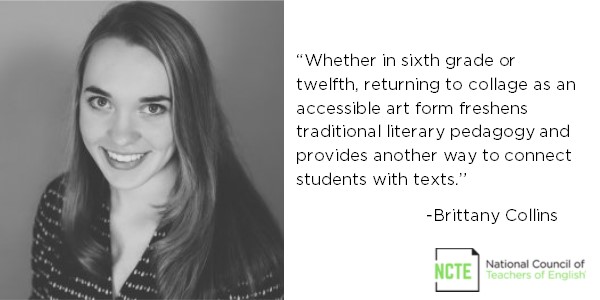This post is written by member Brittany Collins.
As disparate experiences cohere and craft a single identity, so do collages comprise the varying parts of a “whole.” On a January morning in 2016, a roomful of first-year students stared at me eagerly, if skeptically, with papers heavy from glue-stick smudge and Scotch tape. My being at the front of their classroom was a change in their routine. I was invited to present a guest lecture and lesson on intersectionality in The House on Mango Street, which they had been reading for the past week, and my presence was preceded by a request for them to create a “collage of home” prior to our time together. “A collage?” they had whispered, “Like, the kind we made in elementary school?” With amusement and an appreciation for metaphor, I asked the following of students:
Please create an 8.5×11 inch collage that represents “home” to you. Feel free to draw, write, cut pictures out of magazines, or print from the internet—get creative and have fun! While creating your collage, consider the ways in which your home extends beyond your physical living space (though you may choose to include pictures of that, too), and do your best to portray those notions of home on paper. Ex: What does “home” smell, taste, or sound like? Who is “home” to you? What emotions represent home for you? Think of a time when you felt “at home”—what were you doing? Please do not put your name anywhere on your collage, as we will keep these pieces of artwork as anonymous as possible.

After a rumble of giggles spread around our room, students became serious as they tacked their creations to the whiteboard; without conversing, we toured our “Gallery of Home,” and when students settled back into their seats, I structured our debrief with a five-minute, guided free-write:
What did you notice about these collages—similarities, differences?
What can we learn about “home” from these collages?
How did it feel to create your collage? What was challenging?
“I like to think of Cisneros’s novel as a literary collage because each vignette is like a snapshot or picture that can be appreciated on its own and in relation to the text as a whole,” I shared with students as they looked up from their pages. “What connections, if any, do you notice between your collages and The House on Mango Street?”
Because this was an international boarding school, students had varying perspectives on family and culture, tradition and expectation, that they shared in relation to Esperanza’s negotiation of those topics in Cisneros’s novel. The collages no longer seemed trite; instead, they seemed the vehicles through which students shared and reconsidered their lives; they provided a “way in” to differences and similarities.
Drawing from students’ comments, scribbled in purple Expo-marker in my hurried whiteboard penmanship, I shared closing remarks with my students-for-the-day:
All of us, as we grow, are faced with messages about who we are as individuals. It is important to consider the factors that shape us so that we can be more intentional and self-aware through our own processes of maturing—recognizing societal messages and beliefs that we may have internalized about our own identities and considering the ways in which our actions might subconsciously affect somebody else’s idea of themselves. What goes on outside of our homes has a direct impact on how we feel inside of our homes, both literally and figuratively, and this story inspires us to think critically about these internal and external worlds.
The discourse that permeated our classroom catalyzed close reading and community building, explicitly acknowledging the internal and external. Some students considered anew the identifiers that comprise their identities: “Can I say carrot lover?” one girl asked with a smile, while others shared caregiver, Korean, lacrosse player, and daughter and noted the multiplicity and inseparability of all that their “home[s]” and selves contain. Our depth of conversation seemed dependent on the aesthetic “ice-breaker” of collage—the controlled contemplation of the personal in public.
Relational and social-emotional learning are embedded in opportunities where the subjective enters the academic, and collage assignments are one way to scaffold this combination. As January snowstorms give way to sun rays, the spirit of my assignment endures. Whether in sixth grade or twelfth, returning to collage as an accessible art form freshens traditional literary pedagogy and provides another way to connect students with texts. To deepen summer reading and recall the classic (if banal) “What I Did on My Summer Vacation” essay, educators might use collaging as an analytical practice, asking students to identify key themes, conflicts, and characters in a novel before collecting, during their summer adventures, materials that relate to those identified topics. For example, if I were to fulfill this assignment for The Odyssey, I might collect pieces of my own summer “journey”—a road trip, or even my drive to work—and exhibit a road map, examples of “hospitality” (pictures from a hotel pamphlet, perhaps), a picture of my dog (my own Argos), or a picture of my grandmother, herself a great orator. The purpose of this assignment is not to discern how our times resemble a given book, but rather how that book resembles our times, no matter its date of publication. What of great literature endures? Is the human condition one of stasis or change? How do you connect with your summer reading? What in your life resembles its sentiments? These are the questions behind glue-stick smudge and Scotch tape.
Brittany Collins is the editor-in-chief of Voices & Visions, the only online literary journal to publish the visual and written works of students who attend women’s educational institutions worldwide. She studied English and education at Smith College, has experience teaching literature and writing in educational and extracurricular settings, and is a freelance writer with a focus on English education.

